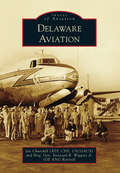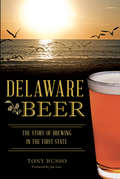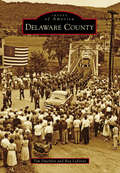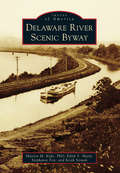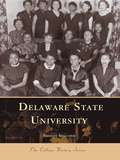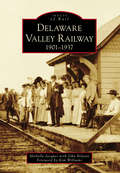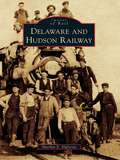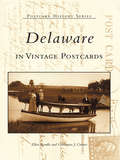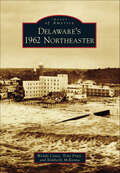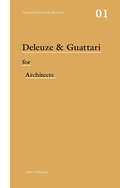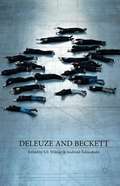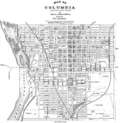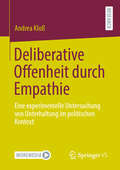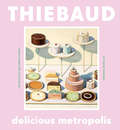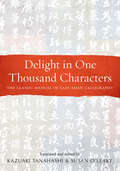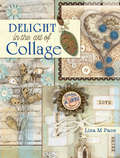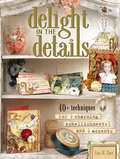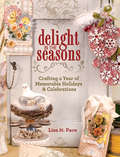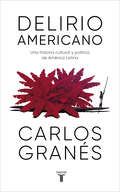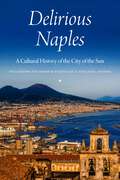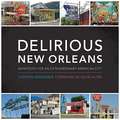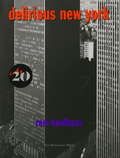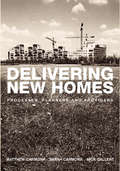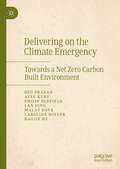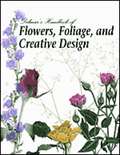- Table View
- List View
Delaware Aviation (Images of Aviation)
by Brig. Gen. Wiggins Jr. Jan ChurchillFor such a small state, Delaware has a fascinating aviation history. Delaware counts aircraft from the smallest, like the 1910 Delaplane, to the largest, the USAF C-5 Galaxy airlifter, among its rich variety. Numerous small grass airstrips dotted the state in the early years, serving as an incubator for aerial progress. The state has been a home to aircraft manufacturers, notable aviators, and aeronautical innovators and hosts military aviation units from the Army National Guard, the Air National Guard, the US Air Force, and the Air Force Reserve on two major bases. World War II brought the development of Dover Air Force Base, currently the largest aerial superport in the United States. This collection of historical photographs depicts the colorful people, the locales, the varied aircraft, and the milestone events that make up the history of aviation in Delaware.
Delaware Beer: The Story of Brewing in the First State (American Palate)
by Tony Russo Jim LutzBoasting a brewing history older than the United States, Delaware packs an outsized punch in the craft beer scene with its landmark breweries and bold flavors. In 1873, the German lagers of Wilmington's Diamond State brewing rose to dominance. After Prohibition and the bust of the first craft beer bubble, entrepreneurial homebrewers resurrected the industry. Sam Calagione of Dogfish Head led the charge by rewriting the state's beer legislation, and the field opened to other brewpubs like Stewart's and Iron Hill to pair savory bites with their brews. By 2009, production breweries like 16 Mile and Fordham & Dominion were on the rise, changing the arc of Delaware beer. Beer writer Tony Russo tells a story of big risks and innovative brewers and proves that there has never been a better time to drink local.
Delaware County: A Catskill Land And Its People, 1791-2007 (Images of America)
by Tim Duerden Ray LafeverDelaware County is located in New York's Catskill Mountains, a region well known as a vacation spot for urbanites. Early settlers farmed the hillsides and valleys, while others sought the raw materials in the forests. By 1797, the population had increased, so the region officially became known as Delaware County. By the 1880s, the county comprised 19 towns, the same number as today. It was around that time when dairy farming became the mainstay of the local economy. However, during the last half century, traditional dairying has declined, and a great deal of agricultural land has been bought up by those seeking an escape from the city. New York City residents' need for fresh water has resulted in the construction of two 20th-century reservoirs within Delaware County's borders and the inundation of several communities. Meanwhile, the waters and the forests have remained, continuing to enrich the county by providing sustenance and comfort.
Delaware River Scenic Byway
by Keith Strunk Marion M. Kyde Edith S. Sharp Stephanie FoxThe river, the road, the rails, and the ribbon of canal--these four parallel transportation arteries define the historic corridor that is the Delaware River Scenic Byway. From the French and Indian Wars and the definitive Battle of Trenton in the colony of New Jersey to the mule-drawn barges, river steamboats, and puffing steam engines of the coal-fired Industrial Revolution, this corridor supported the formation and growth of the country. From the barracks and battlefields of Trenton to the mills and farms of Prallsville and Frenchtown, the modern visitor can trace an explosion of invention and ingenuity. Delaware River Scenic Byway showcases the rich industrial, commercial, and recreational history of this landmark New Jersey roadway.
Delaware State University
by Bradley SkelcherSince its founding in 1891, Delaware State University has proven to be an influential leader in the campaign for equal and quality higher education for students coming from disadvantaged backgrounds in the state of Delaware. Originally the State College for Colored Students, the school was established in response to the Second Morrill Land Grant Act, which required states to allow African Americans entrance into state colleges or to create separate schools for such students. Born in the age of segregation, this proud institution has weathered the storms of over a century and, with vision and persistence, transformed itself into a highly regarded, four-year university. Containing over two hundred black-and-white photographs, Delaware State University tells the remarkable story of a beloved college. The faces and deeds of faculty and students--from professional athlete John Taylor to Ambassador Jerome Holland, from Civil Rights activist Ethel Belton to jazz great Clifford Brown--are depicted in this volume, as well as historical events that came to bear on university life, such as the training of pilots through the Civilian Pilot Training Program and the desegregation that stemmed from the Civil Rights Movement. Reflecting the changing landscape of American society, Delaware State University continues to reinvent itself and endeavors, always, to instill in its students the truth that "Only the Educated are Free."
Delaware Valley Railway: 1901-1937 (Images of Rail)
by Foreword By Williams Michelle Jacques BeljeanFrom 1901 to 1937, the lone engine of the Delaware Valley Railway chugged up and down its solitary track, from the Stroudsburgs to Bushkill. It was a time of heady prospects as the resorts of the Delaware Water Gap pushed north up the valley. Modest farmhouses became vacation boardinghouses, and some then blossomed into grand hotels. The railway brought in vacationers by the carload, but it was not just about tourism. The dinkey hauled in coal for winter heat and hauled out lumber, dairy, and farm produce that kept the farmers in cash. Farm children commuted to town to earn their high school degrees. For more than a generation, the dinkey’s whistle blowing over the valley linked its people and places.
Delaware and Hudson Railway
by Marilyn E. DufresneThe Delaware and Hudson Railway has a grand and glorious history that began in the coal mines of Pennsylvania. The Delaware and Hudson Canal; Gravity Railroad; the Stourbridge Lion, the first locomotive in America in 1829; and the Albany and Susquehanna Railroad provided the necessary stepping stones for successfully transporting anthracite by rail to New York State. In 1906, the massive roundhouse was built in Oneonta during the glory days of steam power, and in 1931 the company became known as the Delaware and Hudson Railway. Today the railroad serves as a "bridge line," providing an important link in moving heavy freight. Delaware and Hudson Railway enlightens rail fans with historic photographs and rekindles the nostalgia for the great railroad era.
Delaware in Vintage Postcards (Postcard History)
by Ellen Rendle Constance J. CooperIf a picture is worth a thousand words, then the 200 historic views in Delaware in Vintage Postcards provide eloquent commentary on the First State in the early part of the twentieth century. Capturing the era between 1905 and 1925, this charming retrospective takes readers on a journey from Selbyville and Fenwick Island to Claymont, Arden, and Hockessin, and down the picturesque Main Streets of more than fifty Delaware towns. Illustrated postcards, which became popular at the turn of the last century, highlight the economic importance of land and sea, the state's varied architectural beauty, and the everyday lives of Delaware citizens.
Delaware's 1962 Northeaster (Images of America)
by Tony Pratt Wendy Carey Kimberly McKennaDelaware�s March 1962 storm caused unprecedented destruction to life and property. Unusually high wind-driven tides carried breaking waves inland, destroying buildings and structures that, ordinarily, would have been beyond the reach of the surf. These photographs and the story they tell about devastation and destruction carry a strong message about hazards, risks, and the vulnerability of Delaware�s communities and environments.
Deleuze & Guattari for Architects (Thinkers for Architects)
by Andrew BallantyneThe work of Gilles Deleuze and Felix Guattari has been inspirational for architects and architectural theorists in recent years. It has influenced the design work of architects as diverse as Greg Lynn and David Chipperfield, and is regularly cited by avant-gardist architects and by students, but usually without being well understood. The first collaboration between Deleuze and Guattari was Anti-Oedipus: Capitalism and Schizophrenia, which was taken up as a manifesto for the post-structuralist life, and was associated with the spirit of the student revolts of 1968. Their ideas promote creativity and innovation, and their work is wide-ranging, complex and endlessly stimulating. They range across politics, psychoanalysis, physics, art and literature, changing preconceptions along the way. Deleuze & Guattari for Architects is a perfect introduction for students of architecture in design studio at all levels, students of architecture pursuing undergraduate and postgraduate courses in architectural theory, academics and interested architectural practitioners.
Deleuze and Beckett
by S. E. Wilmer Audronė ŽukauskaitėDeleuze and Beckett is a collection of essays illuminating similarities between the philosophies and practices of Deleuze and Beckett. The contributors include some of the leading Beckett and Deleuze specialists in the world, and their essays address different ideas and concepts of Deleuzian philosophy as well as a wide range of Beckett's oeuvre, including his novels, short stories, stage and television plays, and film work. The book considers Deleuze's interpretation of Beckett's work anddemonstrates that Deleuzian concepts and ideas can be usefully applied to Beckett's texts in order provide a greater understanding of Beckett's characters and their journeys. Deleuze's philosophy helps us to recognize that what has been seen as the private territory of despair, loneliness, and emptiness in Beckett's work masks a world of flow and fluctuation that expresses multiple and heterogeneous possibilities.
Delia's Tears: Race, Science, and Photography in Nineteenth-Century America
by Molly RogersIn 1850 seven South Carolina slaves were photographed at the request of the famous naturalist Louis Agassiz to provide evidence of the supposed biological inferiority of Africans. Lost for many years, the photographs were rediscovered in the attic of Harvard's Peabody Museum in 1976. In the first narrative history of these images, Molly Rogers tells the story of the photographs, the people they depict, and the men who made and used them. Weaving together the histories of race, science, and photography in nineteenth-century America, Rogers explores the invention and uses of photography, the scientific theories the images were intended to support and how these related to the race politics of the time, the meanings that may have been found in the photographs, and the possible reasons why they were "lost" for a century or more. Each image is accompanied by a brief fictional vignette about the subject's life as imagined by Rogers; these portraits bring the seven subjects to life, adding a fascinating human dimension to the historical material.
Deliberative Offenheit durch Empathie: Eine experimentelle Untersuchung von Unterhaltung im politischen Kontext
by Andrea KloßAndrea Kloß geht vor dem Hintergrund der zunehmenden gesellschaftlichen Polarisierung der Frage nach, welchen Beitrag fiktionale Unterhaltungsmedien leisten können, um bei ihrem Publikum Empathie und deliberative Offenheit im Diskurs mit Andersdenkenden zu fördern.In zwei experimentellen Studien mit Teilnehmern unterschiedlicher Bildungsniveaus kann die Autorin zeigen, dass Transformationsgeschichten, die eine versöhnliche Annäherung zwischen zwei Filmcharakteren mit gegensätzlichen Überzeugungen darstellen, bei den Rezipienten das gleichzeitige Erleben von Empathie für beide Charaktere begünstigen und dadurch ihre Offenheit für andere Ansichten stärken.
Delicious Metropolis: The Desserts and Urban Scenes of Wayne Thiebaud
by Wayne ThiebaudDelicious Metropolis brings together two of Wayne Thiebaud's most celebrated bodies of work: desserts and cityscapes. Between the two, fascinating juxtapositions develop. The layers of a Neapolitan cake echo the shadows cast across a street in the late afternoon. The pastel hues of iced sponge cakes match California's candy-colored houses. Curators, critics, and artists guide the reader through the book via insightful bite-size essays. This gorgeous hardcover offers fans and newcomers a refreshing and accessible way to enjoy the oeuvre of this iconic American painter. Complete with multicolored page edges evoking the layers of one of Thiebaud's mouthwatering cakes, it's a treat for art lovers, city-dwellers, and gourmets alike.
Delight in One Thousand Characters: The Classic Manual of East Asian Calligraphy
by Susan O'Leary Kazuaki TanahashiA beautifully curated presentation of the Thousand Character Essay, a masterpiece of Chinese calligraphy that has served as the art form's classic manual for over 1,400 years. Sung to infants as a lullaby, used to teach reading and writing, and employed as library index codes, the Thousand Character Essay is China's most widely used and beloved calligraphy textbook. Composed by the literary giant Zhou Xingsi and handwritten by sixth-century Buddhist monk Zhiyong, this masterful work has endured for centuries as the standard guide for brush writing both in formal and cursive scripts.Delight in One Thousand Characters brings this sublime body of art-as-text to English-speaking readers through its translation and explanation by calligraphers and artists Kazuaki Tanahashi and Susan O'Leary. Preserving the renowned beauty of monk Zhiyong's only extant handwriting, the book visually depicts the traditional script through extensive imagery, including a full, one-hundred-strip edition of Zhiyong's calligraphy. All images also have corresponding commentary explaining the meaning of each character. Essays and appendices by Tanahashi and O'Leary detail the fascinating history, geographic range, and aesthetic nuance of the essay and of Zhiyong's rendering--essential material to be familiar with the history, thought, literature, and art of East Asian civilization. For calligraphers, Delight in One Thousand Characters can serve as an advanced primer for practicing both formal and cursive Chinese calligraphy.
Delight in the Art of Collage: Mixed-media Collage and Assemblage Techniques and Projects
by Lisa M. PaceDelight in the Details! Add a bit of vintage detail to your collage work! In Delight in the Art Collage, Lisa M. Pace shares an abundance of mixed-media techniques and leads you step-by-step through 40 vintage-inspired projects! Inside, you'll find projects that focus on textiles, metal, paper, beeswax, and more. You will follow along with step-by-step instruction for beautiful creations such as: A felted wool and zipper-trim fabric collage built upon a background of lace and doilies A mobile (like you've never seen before!) featuring photo-transferred metal embellishments A wildflower-inspired collage of vintage book pages, aluminum punched flowers, and faux resin leaves Easy and fun mixed-media techniques that span a vast variety of materials make this the most delightful offering yet from one of North Light's most beloved artists.
Delight in the Details: 40+ Techniques for Charming Embellishments and Accents
by Lisa M. PaceIt's in the details! Take delight in the details of papercrafting-hand stitches, distressed edges and a little glitter are what make a project extra-special. Delight in the Details will inspire you with more than 40 techniques for creating accents and embellishments that will provide a finishing touch to any papercraft project. Get creative with a variety of materials, from simple paper and fabric scraps to glitter, ink, modeling paste and vintage finds. 100 lovely projects-including greeting cards, scrapbook layouts, mini albums and home decor-showcase the techniques in fabulous form. Plus, take a peak inside the author's studio where pretty vintage details come to life. Learn how to create delightful details like:Shimmering wire sprays Texture paste designs Distressed letters Crepe paper rosettes Delicate felt blooms Button bouquets Vintage paper leaves Perfect for papercrafters and mixed-media artists alike, Delight in the Details helps you make every last detail count!
Delight in the Seasons: Crafting a Year of Memorable Holidays and Celebrations
by Lisa M. PaceMake each season delightful! Lisa Pace is at it again, this time with projects and techniques that will have you celebrating the seasons in style! Let Lisa and her pretty vintage style inspire you with techniques that will expand your perceptions of what papercrafting can be. You'll create beautiful projects and embellishments using a wide variety of both everyday and unexpected materials, while paying homage to your fondest memories of Christmas, summer vacation, Halloween and more. In Delight in the Seasons you'll find: 40 step-by-step techniques, to be used as demonstrated or adapted to meet your style and needs. 20 gallery pieces that combine multiple techniques into entirely new and charming projects. A delightful variety of sample projects including home, seasonal and party decor, greeting cards, ornaments, scrapbook layouts and more. Endless inspiration as Lisa shares the memories and moments that inspired each project. So gather your supplies, add a dash of inspiration (and maybe some glitter) and delight in the seasons with Lisa Pace!
Delirio americano: Una historia cultural y política de América Latina
by Carlos GranésDisfruten con la fantasía de los creadores latinoamericanos y observen las nefastas consecuencias del ensueño de los políticos. Y cómo a veces ambos delirios fueron de la mano. Carlos Granés, uno de los pensadores más sólidos y originales de la actualidad, recompone con gran pulso narrativo el inmenso, intrincado y exuberante puzle del largo siglo XX en América Latina. Por primera vez, los lectores pueden recorrer en un mismo relato las etapas, fuerzas y acontecimientos de una historia tradicionalmente contada de manera fragmentaria y profundamente marcada por las complejas relaciones entre cultura y política. El ensayo traza conexiones sorprendentes, muestra reveladoras contradicciones y retrata a figuras como José Martí, César Vallejo, Nahui Olín, Juan Domingo Perón, García Márquez, Doris Salcedo o Caetano Veloso. Desde las primeras reivindicaciones de una América Latina con identidad propia por parte de poetas y ensayistas, el surgimiento del comunismo y el fascismo latinoamericano y la irrupción del populismo hasta la resaca del boom, las nuevas tensiones entre lo local y lo global y la muerte de Fidel Castro en 2016, el libro rastrea el papel de las ideas y las artes en la invención de América Latina y en la construcción de las identidades nacionales durante las dictaduras y revoluciones. Granés da cuenta con brillantez de la influencia del surrealismo, cuyo impacto decisivo fue también político, pues dio lugar a una alternativa individualista, libertaria e imaginativa a las ideologías totalitarias y al populismo que derivaría en la izquierda heterodoxa y en el liberalismo. Delirio americano es un maravilloso fresco, admirablemente narrado, que amplía nuestra mirada sobre un continente cuya historia y destino afectan a las prácticas políticas y culturales de todo Occidente. La crítica ha dicho... «Carlos Granés es en mi opinión uno de los mejores ensayistas de nuestra lengua. Sus libros están escritos en una prosa precisa y flexible, prodigan ideas frescas y son capaces de abrir perspectivas nuevas sobre viejos problemas.» JAVIER CERCAS «Granés es uno de los mejores ensayistas actuales, un escritor brillante y perspicaz».El Confidencial «No creo que nadie haya trazado un fresco tan completo, animado y lúcido sobre todas las vanguardias artísticas del siglo XX. Lo he leído con la felicidad y la excitación con que leo las mejores novelas».Mario Vargas Llosa, sobre El puño invisible «Granés vuelve a dar en el clavo con un ensayo capaz de captar la atención del lector sobre un tema de actualidad y enorme alcance».Forbes, sobre Salvajes de una nueva época «Ameno y riguroso ensayo sobre la liaison de la cultura, el capitalismo y la política».ABC, sobre Salvajes de una nueva época «La política se vuelve vocinglera y el capitalismo vira a lo correcto. Este ensayo pone en limpio lo que parece inconexo».El Mundo, sobre Salvajes de una nueva época
Delirious Naples: A Cultural History of the City of the Sun
by Pellegrino D’Acierno and Stanislao G. PuglieseThis book is addressed to “lovers of paradoxes” and we have done our utmost to assemble a stellar cast of Neapolitan and American scholars, intellectuals, and artists/writers who are strong and open-minded enough to wrestle with and illuminate the paradoxes through which Naples presents itself. Naples is a mysterious metropolis. Difficult to understand, it is an enigma to outsiders, and also to the Neapolitans themselves. Its very impenetrableness is what makes it so deliriously and irresistibly attractive. The essays attempt to give some hints to the answer of the enigma, without parsing it into neat scholastic formulas. In doing this, the book will be an important means of opening Naples to students, scholars and members of the community at large who are engaged in “identity-work.” A primary goal has been to establish a dialogue with leading Neapolitan intellectuals and artists, and, ultimately, ensure that the “deliriously Neapolitan” dance continues.
Delirious New Orleans: Manifesto for an Extraordinary American City
by Stephen VerderberFrom iconic neighborhoods such as the French Quarter and the Garden District to more economically modest but no less culturally vibrant areas, architecture is a key element that makes New Orleans an extraordinary American city. Delirious New Orleans began as a documentary project to capture the idiosyncratic vernacular architecture and artifacts-vintage mom-and-pop businesses, roadside motels, live music clubs, neon signs, wall murals, fast-food joints, and so on-that helped give the city's various neighborhoods their unique character. But because so many of these places and artifacts were devastated by Hurricane Katrina, Delirious New Orleans has become both a historical record of what existed in the past and a blueprint for what must be rebuilt and restored to retain the city's unique multicultural landscape. Stephen Verderber starts with the premise that New Orleans's often-overlooked neighborhoods imbue the city with deep authenticity as a place. He opens Delirious New Orleans with a photo-essay that vividly presents this vernacular architecture and its artifacts, both before Katrina and in its immediate aftermath. In the following sections of the book, which are also heavily illustrated, Verderber takes us on a tour of the city's commercial vernacular architecture, as well as the expressive folk architecture of its African American neighborhoods. He discusses how the built environment was profoundly shaped by New Orleans's history of race and class inequities and political maneuvering, along with its peculiar, below-sea-level geography. Verderber also considers the aftermath of Katrina and the armada of faceless FEMA trailers that have, at least temporarily and by default, transformed this urban landscape.
Delirious New York: A Retroactive Manifesto for Manhattan
by Rem KoolhaasSince its original publication in 1978, Delirious New York has attained mythic status. Back in print in a newly designed edition, this influential cultural, architectural, and social history of New York is even more popular, selling out its first printing on publication. Rem Koolhaas's celebration and analysis of New York depicts the city as a metaphor for the incredible variety of human behavior. At the end of the nineteenth century, population, information, and technology explosions made Manhattan a laboratory for the invention and testing of a metropolitan lifestyle -- "the culture of congestion" -- and its architecture."Manhattan," he writes, "is the 20th century's Rosetta Stone . . . occupied by architectural mutations (Central Park, the Skyscraper), utopian fragments (Rockefeller Center, the U.N. Building), and irrational phenomena (Radio City Music Hall)." Koolhaas interprets and reinterprets the dynamic relationship between architecture and culture in a number of telling episodes of New York's history, including the imposition of the Manhattan grid, the creation of Coney Island, and the development of the skyscraper. Delirious New York is also packed with intriguing and fun facts and illustrated with witty watercolors and quirky archival drawings, photographs, postcards, and maps. The spirit of this visionary investigation of Manhattan equals the energy of the city itself.
Delivering New Homes: Planning, Processes and Providers
by Nick Gallent Sarah CarmonaThis book examines the processes and relationships that underpin the delivery of new homes across the United Kingdom, focussing primarily on the land use planning system in England, the way that housing providers engage with that system, and how the processes of engagement are changing or might change in the future. Planning, market and social house building - the three key processes - are first dissected and explored individually, then brought together to study the key areas of interaction between planning and the providers of social and market housing by way of the range of tensions that have consistently dogged those interactions. Extensive illustrative case study material provides a platform to the consideration of developing more integrated, realistic and proactive approaches to planning.Proposing evolutionary, and sometimes radical proposals for change, Delivering New Homes makes a bold contribution to finding a better way of delivering the new homes that the nation increasingly needs.
Delivering on the Climate Emergency: Towards a Net Zero Carbon Built Environment
by Philip Oldfield Deo Prasad Aysu Kuru Lan Ding Malay Dave Caroline Noller Baojie HeThis book focuses on the transition towards net-zero carbon built environments to deliver on the climate emergency. It provides an evidence-based roadmap and proposes guidelines to achieving targets covering emerging technologies, materials, innovative design, regulations and policies.
Delmar's Handbook of Flowers, Foliage, and Creative Design
by Norah T. HunterThe Handbook of Flowers, Foliage, and Creative Design is a practical guide for anyone who enjoys the art of floral design. This book provides easy access to basic information as well as step-by-step floral arrangement instructions, a full-color flower and foliage identification section, and a glossary containing technical terminology used within the industry.
